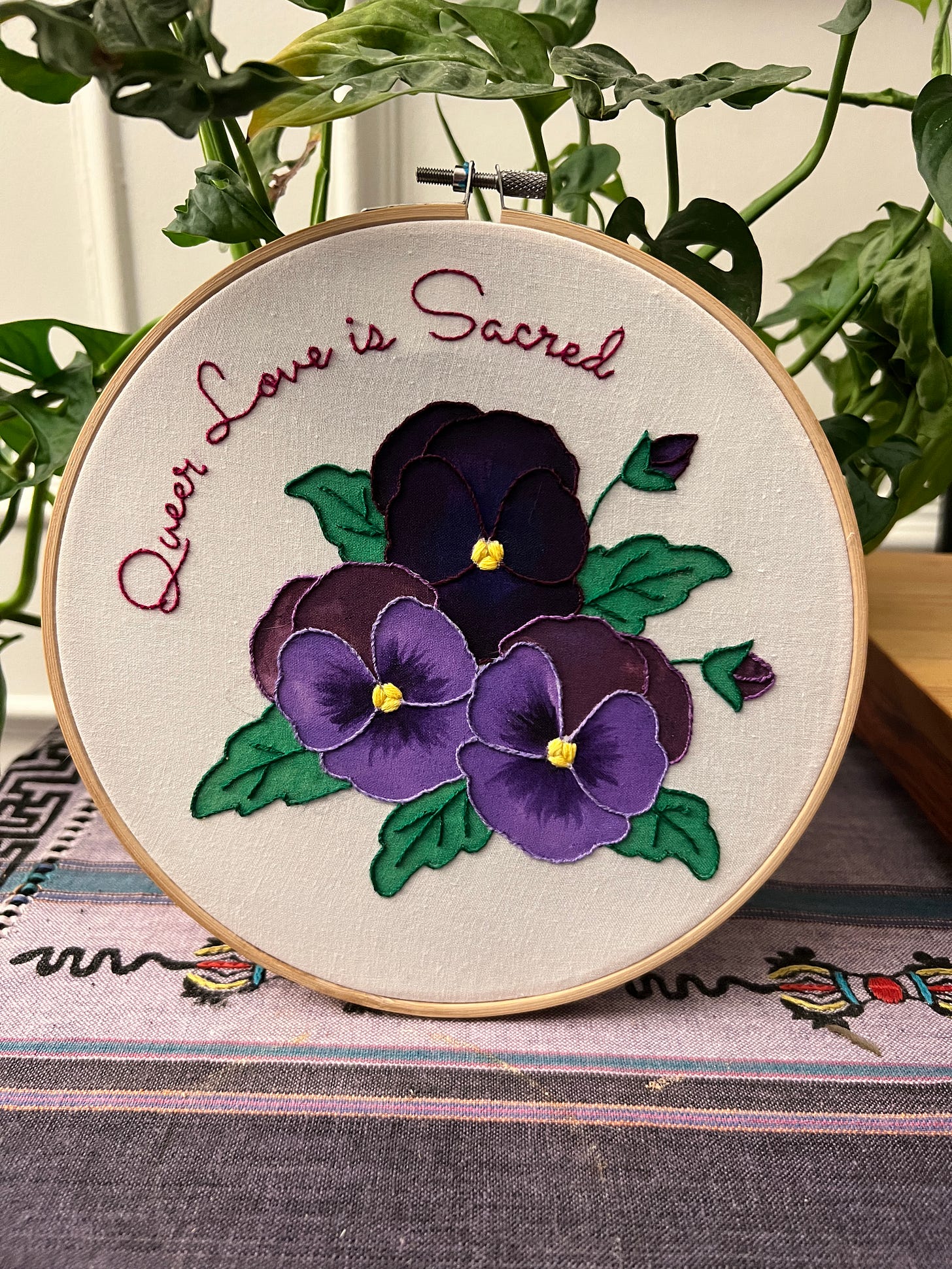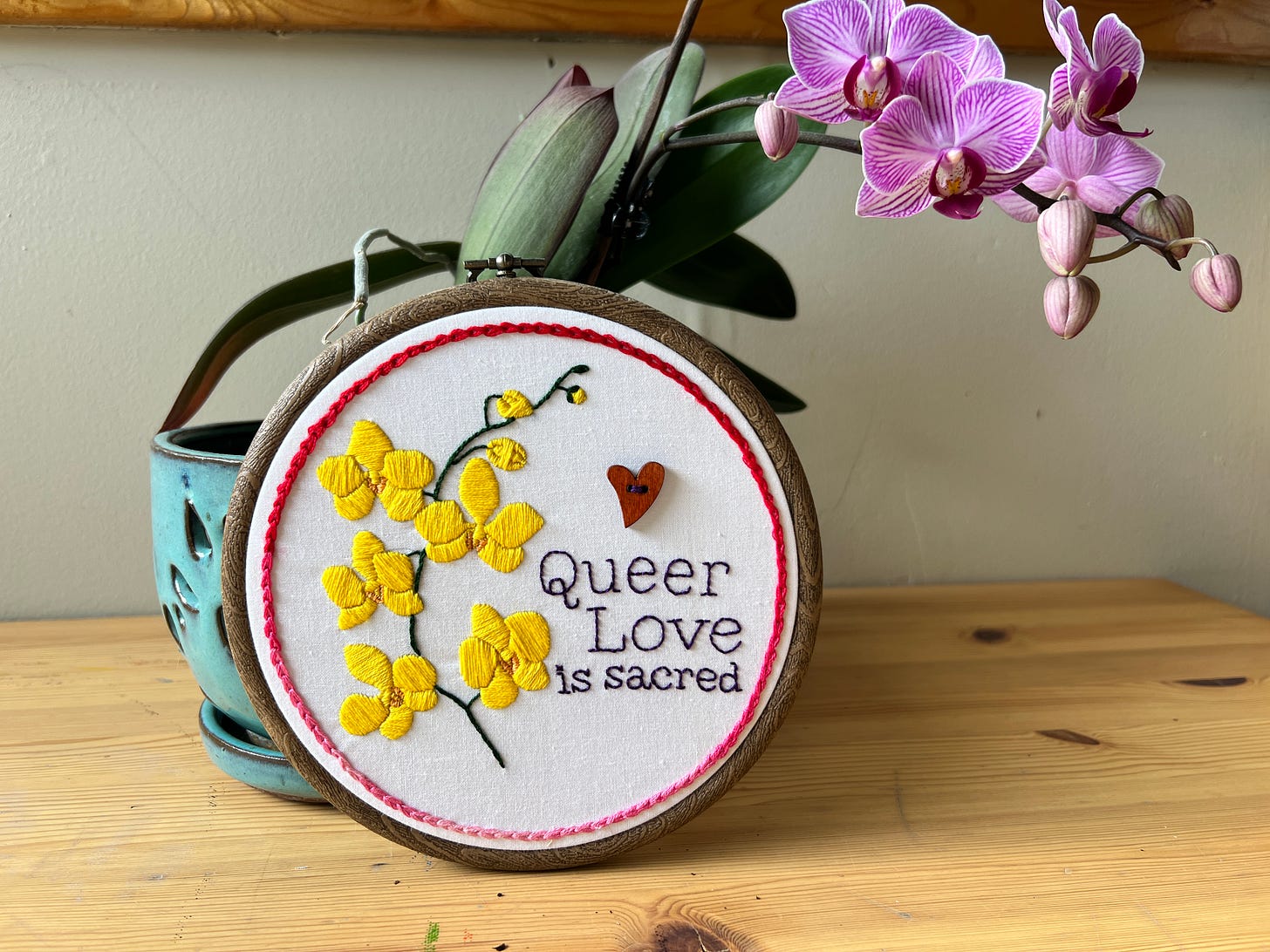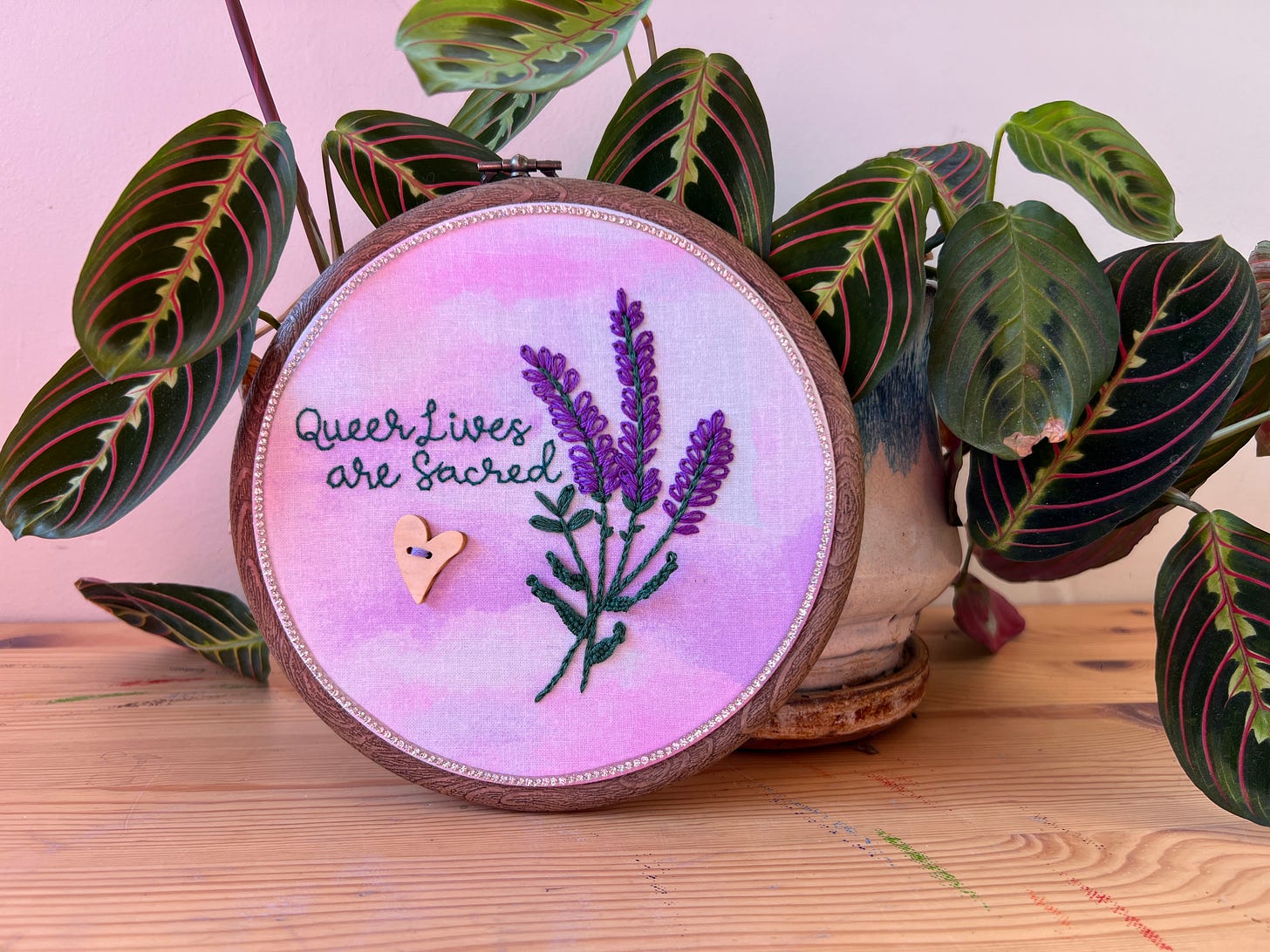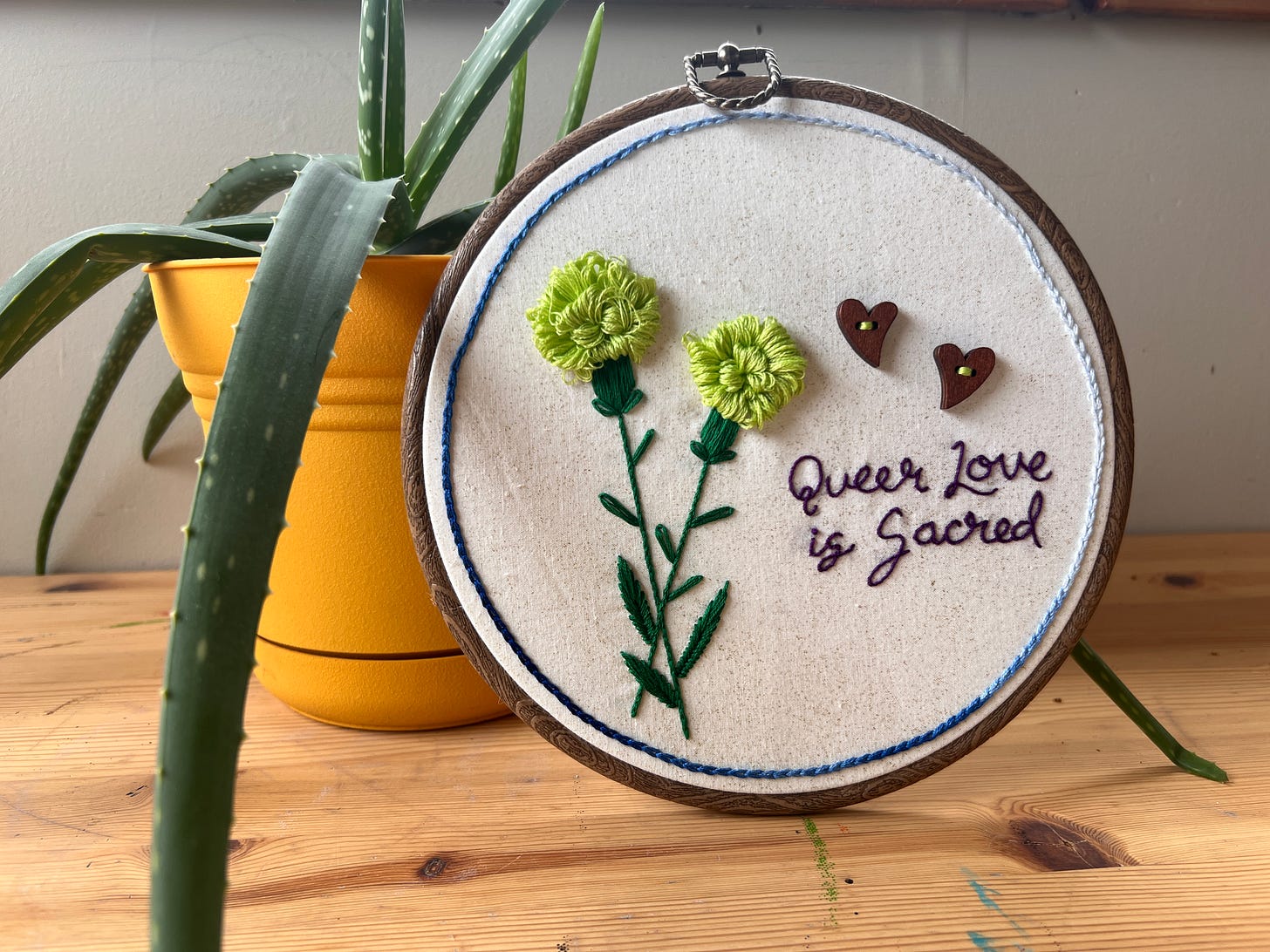Sacred Love & Lives: Spring Flowers
More Sacred Love/Sacred Lives artist statements
Reading time: About 6 minutes

Sacred Love/Sacred Lives is a mixed-media embroidery art project I began at the end of 2022. I shared an initial round of artist statements in November 2023. Since then I have continued to work on artist statements for each piece in the series as and am publishing the statements here as I complete them.
Don’t let anyone tell you your life and who you love and how you love is anything less than sacred.
Queer Love is Sacred, trio of pansies design
Mixed-media: 8” hoop, acrylic paint, fabric marker and embroidery floss
The pansy has long been a symbol of the queer community, but not always in the best way. “Pansy” isn’t exactly a slur, but it was and sometimes still is used to degrade effeminate men. It is an example of reclaiming a term weaponised against queer folks. Like lesbians opting to embrace being called the lavender menace and taking up ‘dyke’ with pride, gay men happily referring to themselves as pansies takes the bite out of the word, turning something used to hurt and demean into something powerful and even fun.
This piece represents the power of choosing the words we want and reclaiming the words cishets would use to harm us.
Queer Love is Sacred, golden orchid design
Mixed-media: 6” hoop, wooden bead, and embroidery floss
I learned about the Golden Orchid societies of China thanks to the Making Queer History project. Originating in the Qing dynasty, these societies were an option for women who didn’t want to marry or become Buddhist nuns. They would live in intentional community with other women, and while they weren’t necessarily queer communities, they provided a safe haven for many lesbians and even a way for women to marry other women.
This piece is in honour of this little slice of interesting history about a community where women could be in openly intimate and romantic relationships with each other.
Intersex Lives are Sacred, Intersex rose design
Mixed-media: 8” hoop, acrylic paint, fabric marker and embroidery floss
I decided to make this piece while reading Pigeon Pagonis’ incredible memoir, Nobody Needs to Know. I have been following their work for years, apparently since a few months into their campaign to have Lurie Children’s hospital in Chicago stop doing unnecessary surgeries on Intersex infants.
Roses have long been used as symbols across the spectrum of the queer community, but this specific rose design in the Intersex colours was used to uplift the importance of bodily autonomy of Intersex infants. You may have heard that gender isn’t a binary, but neither is sex. Anywhere between 1 and 2 % of the population are born with Intersex traits, traits which are completely harmless to have and, as many Intersex advocates will speak to, just normal human variations.
And yet, doctors insist on doing invasive, permanent surgeries on Intersex babies in order to force their genitals to conform to a restrictive so-called ideal. Doctors also often lie to parents about the surgeries, telling them they are necessary when they are anything but. A growing movement of Intersex adults, like Pagonis, now speak up loudly and proudly about the importance of letting Intersex people decide for themselves when they are able to about whether or not to have surgeries—particularly as these surgeries can render people infertile and cause discomfort, numbness and pain, all simply for the sake of genitals looking a certain way.
This is the first piece I made that introduced an additional phrase to the Sacred Love/Sacred Lives series, which started with uplifting disabled, trans and queer lives. While many Intersex people may be trans or queer, not all of them are, and so it felt important to be explicit with the phrase I stitched on this piece.
Queer Lives are Sacred, lavender trio design
Mixed-media: 6” hoop, wooden bead, stick on rhinestones and embroidery floss
Lavender has been a symbol of queer communities throughout time, but in making this piece I particularly wanted to uplift the work of the Lavender Menace, an informal coalition of lesbians who fought for lesbian representation in the feminist movement of the 1960s and 70s. The name actually came from cishet feminists referring to lesbians in the feminist movement as somehow a problem, but was embraced by feminist lesbians with pride.
Like the issue we face these days with Trans Exclusionary “feminists”, this as an example of when a movement is fighting for liberation, but only for a select few, ultimately benefiting the status quo and perpetuating the very systems they claim to be against. It’s a view where a group is fighting for a seat at the table, rather than recognizing that the table wasn’t built for them, and in fact is full of rot and not really worth sitting at.
The Lavender Menace group are an example of bringing an intersectional lens to feminism—fighting for feminism that includes gender liberation for everyone, not just cisgender, white, abled, middle-class or wealthy women and not just women but all genders.
Queer Love is Sacred, green carnation design
Mixed-media: 8” hoop, wooden beads, and embroidery floss
Oscar Wilde is said to have popularised the green carnation as a way for gay men to signal to one another and show pride and solidarity. Historical accounts claim that this fad started off at the premier of Lady Windermere’s Fan in 1892, when many in the audience, and even one cast member, were seen wearing green carnations in their lapels.
The flower gained popularity rapidly and soon the general public, not just gay men, understood the meaning. Because the meaning was no longer confined to just gay men, it turned those who wore the green carnation into targets, including Wilde. The affiliation with the green carnation was one factor in Oscar Wilde’s arrest for “gross indecency”.
Wilde has long been an example to me of a queer ancestor who lived life fully, despite a society that criminalised homosexuality. Today, as conservative governments and politicians are attacking trans people and drag performers, and banning books with any mention of 2SLGBTQI folks, I often think of his defiance in the face of oppression. In many ways, we are living a life Oscar Wilde, and so many other queer ancestors, only dreamed of. And yet we must still fight so younger and as of yet unborn generations of 2SLGBTQI folks can live the lives of liberation we are dreaming of now.
I am seeking to collaborate with other artists for this series.
If you have an idea for a design that would work for this series, please get in touch! You can email me: hello ‘at’ kschatch ‘dot’ com or look at the online gallery of this project to learn more.








